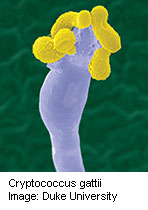- How Savvy Habits May Help Head Off Dementia
- HHS Launches New Autism Study Despite Experts’ Concerns
- CDC Urges Extra Measles Shot For Some U.S. Travelers Amid Outbreak
- Showerhead Water Limits Rescinded as Trump Targets Household Appliances
- Most Women Aren’t Clear When Menopause Might Start
- New Visual Test For Autism Could Aid Earlier Diagnosis
- Half-Million Children Could Die If U.S. AIDS Relief Is Dropped
- Seasonal Allergies Likely To Grow Worse Under Climate Change
- First Baby Born From Robot-Controlled IVF
- Eviction Bans Linked To Drop In Child Abuse Reports
California Trees Harbor Fungus Deadly to People With HIV


A potentially deadly fungus that has been sickening HIV/AIDS patients in Southern California for decades grows on trees, a new study finds.
The team of scientists who published the research note that they were tipped off to the finding by a teen girl’s science fair project.
The Cryptococcus gattii fungus triggers infections of the lungs and brains and is responsible for a full third of all AIDS-related deaths, the researchers noted. They found that three tree species — Canary Island pine, Pohutukawa and American sweetgum — harbor the fungus and are sources of human infection.
“Just as people who travel to South America are told to be careful about drinking the water, people who visit other areas like California, the Pacific Northwest and Oregon need to be aware that they are at risk for developing a fungal infection, especially if their immune system is compromised,” study author Deborah Springer, a postdoctoral fellow in the Center for Microbial Pathogenesis at Duke University School of Medicine, said in a Duke news release.
However, she and her colleagues owe their discovery to a science fair project conducted by 13-year-old Elan Filler, who gathered tree and soil samples from areas around Los Angeles.
Elan is the daughter of Dr. Scott Filler, an infectious disease specialist the University of California, Los Angeles.
Elan sent samples of C. gattii to the researchers, who compared them with samples from HIV/AIDS patients with C. gatti infections. The samples from three of the tree species were nearly genetically identical to the samples from the patients.
The C gattii samples from the trees were fertile, and able to reproduce sexually or asexually, according to the study published recently in the journal PLoS Pathogens.
“That finding is important for long-term prevalence in the environment, because this fungal pathogen will be able to grow, reproduce, disperse spores and serve as a source of ongoing infections,” Springer explained.
More information
The U.S. Centers for Disease Control and Prevention has more about Cryptococcus gattii.
Source: HealthDay
Copyright © 2025 HealthDay. All rights reserved.










